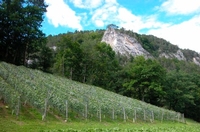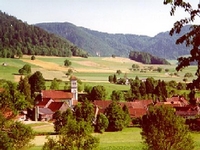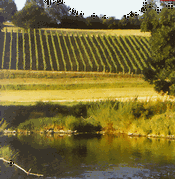In my last posting about France’s Jura district, the topic was the region’s notable white wines. Now I want to point out that Jura reds should not be overlooked either. They may not be as well known among impassioned wine lovers as the whites, but they are equally unique and interesting. Because the flavor profile of Jura wines may be unfamiliar to us, they often seem strange and unfamiliar to palates accustomed to rich, powerful, fruit driven red wine. But challenging though they can be, these wines provides a good opportunity to venture off the familiar grid of the so-called “internationally styled” red wines that so many critics grumble about in articles and blog postings.
accustomed to rich, powerful, fruit driven red wine. But challenging though they can be, these wines provides a good opportunity to venture off the familiar grid of the so-called “internationally styled” red wines that so many critics grumble about in articles and blog postings.
So if you’re one of those folks who’d like to broaden your palate and get to know some wines that aren’t the same-old-same-old, the Jura is terrific place to visit–and I am referring to both the place and the wines. As my husband, Paul, and I discovered when we were there last winter, this region has a lot to offer in addition to its wines. Among the many attractions are the delicious, rustic cuisine, and the fact that the Jura lies in a scenic Alpine setting relatively untrammeled by tourists.
One of the first red wines a visitor may encounter is Poulsard, which is perhaps the oddest of Jura’s reds. Poulsard tends to be pale in color, and it often has a peculiar, almost reductive aroma, but don’t give up on it. One of the surprises of Poulsard is how tasty the good ones can be when paired the hearty regional foods. Try Poulsard with the flavorful local sausages, for example, or with any one of the various chicken dishes that are popular here.
Trousseau is a red with slightly more color than Poulsard. The most interesting versions of it can be appealingly both fruity and gamey, and they finish on a note of pronounced acidity. A reflection of the cool climate here in the foothills of the Alps, this acidity might seem jarring in some of the less-successful wines made with under-ripened fruit, but optimally, when all the elements are in balance, that zing of acidity on the finish can be exceedingly pleasant and refreshing.
Given that the Jura is positioned right next door to Burgundy, there is a fair amount of Pinot Noir here. But given, also, that the elevation is  higher and the climate cooler, Pinots tend to be lighter in color and more delicate overall than their Burgundian counterparts. The best examples of Jura Pinot Noir, however, are wonderfully invigorating and complex.
higher and the climate cooler, Pinots tend to be lighter in color and more delicate overall than their Burgundian counterparts. The best examples of Jura Pinot Noir, however, are wonderfully invigorating and complex.
Rosés may be made from any or all of Jura’s three red grapes. They can be quite good, at times surprisingly substantial, and they are sometimes laced with the kind of tannins more often associated with red wine. The rosés are generally called “Rubis” or “Corail” (Coral). They make good aperitifs and are often exactly the right thing to have with the robust local food.
One of the biggest surprises for me in the Jura was the high quality of the Crémants. Based mostly on Chardonnay, the good ones are knockouts–crisp, clean, bouncy sparklers with loads of personality. They can be as good as–if not better than–most crémants from any other appellation in France. They are obvious choices as an aperitif,  but when you want a wine to contrast with the food rather than something to echo it, crémant is often a good way to go here.
but when you want a wine to contrast with the food rather than something to echo it, crémant is often a good way to go here.
During the few days we spent in the Jura we merely scratched the surface of the wine scene, but I did compile a list of some of my favorite producers (offered here in no particular order). Some of these labels are available in the U.S., but most are not–you’ll just have to go to the Jura to taste them!
Domaine Morel Thibaut, Fruitière Viticole d’Arbois, Domaine de Montbourgeau, Chateau l’Etoile, Domaine Martin Faudot, Frédéric Lornet, Domaine de la Renardière, Chateau d’Arlay, Rolet Père et Fils, Jacques Tissot, Stéphane Tissot, Henri Maire, Domaine Jean Bourdy, Domaine Berthe-Bondet, Domaine Benoit Badoz, Julien Labet, Rijckaert, Baud, Domaine Octaven, Domaine de la Tournelle, Céline et René Treuvey, Domaine Desiré Petit, Domaine de la Pinte, Domaine Daniel Dugois.
7
